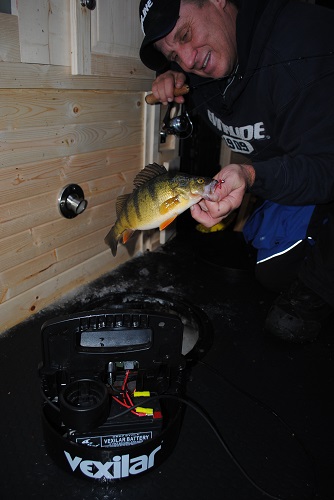 Most open water anglers who fish from a boat wouldn’t think of going out without a sonar unit, also known as a depth-finder. That same thought is true with most ice-anglers. A depth-finder will help you catch more fish, and they are also much more than just a depth-finder. Here’s how. In the mind of many of the most successful ice-anglers, revealing the depth isn’t a depth-finders most important function: Revealing fish is its primary function. A depth-finder tuned properly, and it’s not hard to tune them properly, will show the tiniest of jigs. They will certainly show if a fish is below your hole in the ice. Many ice-anglers will drill a good number of holes in an area and then move from hole to hole searching for fish. They drop the transducer down the hole, drop their bait down, and watch for a fish to approach it. If no fish life is detected, they move to another hole. They keep moving until they find fish. When they find a hole with fish underneath, they spend some time there. This is when the depth-finder assumes a new role.
Most open water anglers who fish from a boat wouldn’t think of going out without a sonar unit, also known as a depth-finder. That same thought is true with most ice-anglers. A depth-finder will help you catch more fish, and they are also much more than just a depth-finder. Here’s how. In the mind of many of the most successful ice-anglers, revealing the depth isn’t a depth-finders most important function: Revealing fish is its primary function. A depth-finder tuned properly, and it’s not hard to tune them properly, will show the tiniest of jigs. They will certainly show if a fish is below your hole in the ice. Many ice-anglers will drill a good number of holes in an area and then move from hole to hole searching for fish. They drop the transducer down the hole, drop their bait down, and watch for a fish to approach it. If no fish life is detected, they move to another hole. They keep moving until they find fish. When they find a hole with fish underneath, they spend some time there. This is when the depth-finder assumes a new role.

Now that we’ve found some fish that might be interested in getting caught, we’re going to use the sonar unit to position our bait. When a group of fish is found, there will usually be some that are more aggressive. Those are the ones we want to target first. Let’s say we’re fishing for perch in twenty feet of water, and the fish we’re seeing are very close to the bottom. Lower your jig or spoon or whatever down about ten feet and see if a perch or two will come up to it. If they do, they’re often going to bite. Catch the biters. If they quit coming up ten feet for the bait, lower it so it’s a little closer to the bottom. Make the aggressive fish come up to the bait. When they quit coming up, lower it closer to the bottom. If you see fish on the bottom and they don’t want to eat the bait you’re using, try a different bait or move to a different hole in search of more aggressive fish. Keep this in mind: Fish will move farther to take a bait in clear water than in dirty water. They can see farther in clear water.
This brings us to another function your sonar will perform. Let’s say you see fish down there, and they come up to look at your bait, but they don’t eat it. This means they’re willing to bite, but they’re being finicky. If they look but don’t eat, you need to do something that will convince them to eat. Try a different color or size. Maybe move the bait slower or faster. If you’re using a jig, try a spoon, or maybe just a plain hook, splitshot and bobber. Try different presentations until you find what they want. If they don’t respond to anything you show them, find a different hole but remember to come back to that one. At some point during the day, they’ll eat.
Consider cone angle. Different transducers have different cone angles. A transducer with an eight degree cone angle will cover about a three foot circle on the bottom: A transducer with a twenty degree cone angle will cover about a seven foot circle. This means that a fish that shows up on a twenty degree transducer might not show up on a transducer with a smaller cone angle.
There are a number of very good depth-finders available to ice-anglers. Vexilar is a pioneer in the industry and produces units with a wide variety of features and some with just the basics. Regardless of your needs or desires in depth-finders, just realize that if you want to be more successful in your ice-fishing, a properly tuned depth-finder will be a huge step in that direction.
To see all the most recent episodes of Fishing the Midwest television, new fishing related tips, and fishing articles from the past, visit fishingthemidwest.com If you do Facebook, check us out for a variety of fishing related things.
